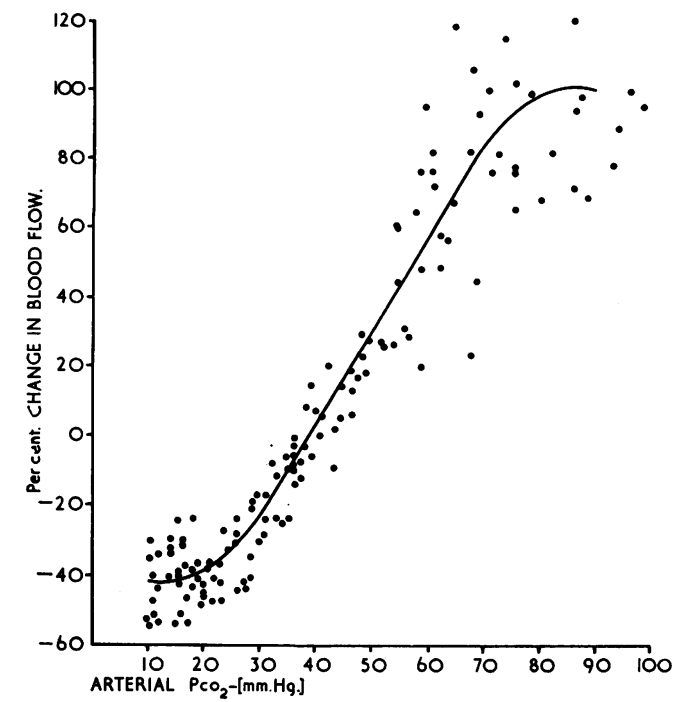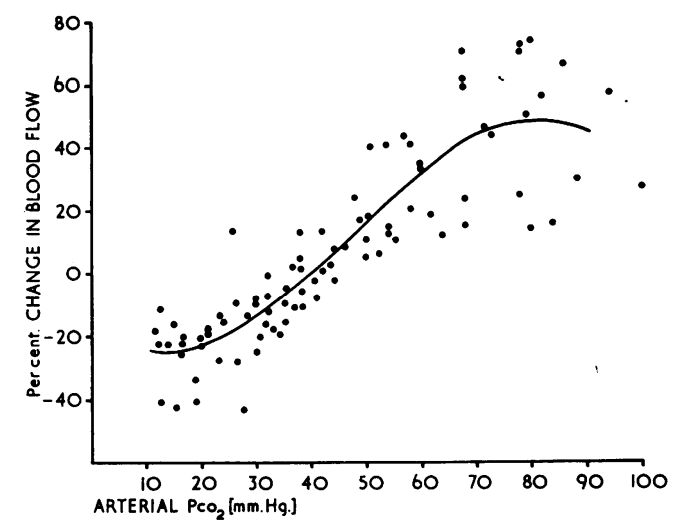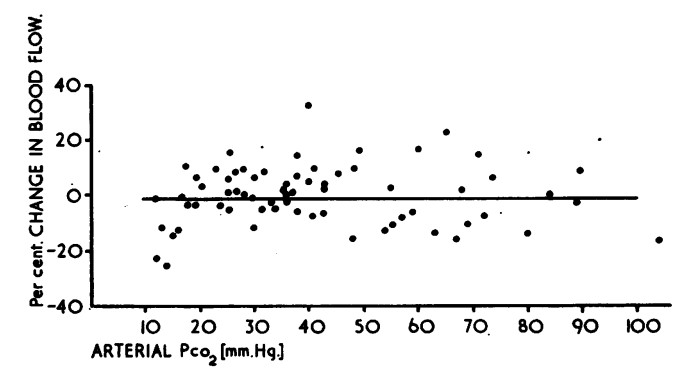正常和低血压时动脉二氧化碳分压对大脑皮层血流量的影响
Effect of alterations in the arterial carbon dioxide tension on the blood flow through the cerebral cortex at normal and low arterial blood pressures
A. MURRAY HARPER AND H. I. GLASS
From the University Department of Surgery, Glasgow Royal Infirmary, and the Wellcome Laboratory, University of Glasgow
格拉斯哥皇家医院的大学外科系和格拉斯哥大学的威康实验室
Harper AM, Glass HI. Effect of alterations in the arterial carbon dioxide tension on the blood flow through the cerebral cortex at normal and low arterial blood pressures. J Neurol Neurosurg Psychiatry. 1965;28(5):449-452. doi:10.1136/jnnp.28.5.449
人工校对DeepL 翻译 序言
It is well known that the cerebral blood flow alters in response to changes in the arterial carbon dioxide tension. However, it is not yet clear whether there are upper and lower limits of , beyond which the cerebral vessels do not react. In addition, there have been no reports on the response of cerebral blood flow to alterations in , in hypotensive states.
众所周知,脑血流会随着动脉二氧化碳分压的变化而改变。然而,目前还不清楚 是否有上限和下限,超过这个上限,脑血管就没有反应。此外,还没有关于低血压状态下脑血流对 改变的反应的报告。
The recent development by Lassen and Ingvar (1961, 1962) of a rapid, easily repeatable, and relatively untraumatic method of estimating the blood flow through the cerebral cortex has enabled us to make multiple estimations of blood flow in lightly anaesthetized dogs at varying tensions of arterial carbon dioxide and varying arterial blood pressures.
Lassen 和 Ingvar(1961 年,1962 年)最近开发了一种快速、易重复、相对无创伤的方法来估计通过大脑皮层的血流量,使我们能够在不同的动脉二氧化碳分压和不同的动脉血压下对轻度麻醉的狗进行多次血流量估计。
方法
Three hundred and two measurements of blood flow through the cerebral cortex were made on 41 unselected mongrel dogs. The animals were anaesthetized with thiopentone. A cuffed endotracheal tube was inserted and connected to a Starling respiratory pump, through which a 4:1 mixture of N2O and oxygen was delivered in open circuit. Suxamethonium chloride was administered at intervals. Repeated small doses of thiopentone were given during the actual operation. A cannula was inserted into the femoral artery and connected to a damped mercury manometer for the measurement of the systemic blood pressure. This cannula was also used for the withdrawal of arterial blood samples.
对 41 只非特异挑选的杂种狗进行了 320 次大脑皮层血流的测量。用硫喷妥钠(超短时作用的巴比妥类药物,常用于静脉麻醉、诱导麻醉、基础麻醉、抗惊厥以及复合麻醉等。硫喷妥钠引起心输出量降低的主要机制为:①降低静脉回流;②直接对心肌的抑制;③中枢性交感传出作用降低。肝脏病,低血压,糖尿病,严重贫血,哮喘病人忌用。)对这些动物进行了麻醉。插入带套囊的气管导管,并与斯塔林呼吸泵相连,通过该呼吸泵以开路方式输送 4:1 混合的 N2O 和氧气。每隔一段时间施用氯化琥珀胆碱。在实际操作过程中,反复给予小剂量的硫喷妥钠。股动脉置管并与阻尼式水银压力计相连,以测量全身血压。这根导管也用于抽取动脉血样。
The thyroid branch of the common carotid artery was cannulated centripetally, the distal end being tied. The temporal muscle was excised and a trephine hole made over the parietal bone. A cruciate incision was made in the dura and the exposed brain cortex was covered with a plastic membrane (Melinex) 6μ in thickness. A thin lead shield was placed over the surrounding dura and bone, leaving exposed only the area of cortex covered by the membrane. An end window Geiger counter, mounted 1 mm. above the exposed cortex, was connected to a ratemeter and a direct writing recorder. After the operation was completed, thiopentone administration was discontinued and the preparation remained undisturbed for one hour before the first measurements of blood flow were made. Plasma substitute (Dextran), saturated with 85 Krypton, was injected, rapidly at first and then more slowly, into the carotid artery over two to three minutes. The blood flow through the brain cortex was calculated from the half-life of the initial slope of a semilogarithmic plot of the clearance curve using the formula of Lassen and Ingvar (1961, 1962). After each measurement of blood flow, blood samples were taken from the femoral artery for the measurement of , and pH on the micro-Astrup apparatus. Arterial oxyhaemoglobin saturation was measured at intervals on a Kipp haemoreflector. Pharyngeal temperatures were measured with a mercury thermometer.
颈总动脉的甲状腺分支置入导管,指向心脏,远端被绑住。切除颞部肌肉,并在顶骨上开一个挖孔。在硬脑膜上做一个十字形切口,用厚度为 6.0 μ 的塑料膜(Melinex)覆盖暴露的大脑皮层。在周围的硬脑膜和骨头上放置一个薄的铅罩,只留下被膜覆盖的皮质区域。在暴露的皮层上方 1 毫米处安装了一个端窗盖格计数器,并与一个速率计和一个直接书写记录器相连。操作完成后,停止使用硫喷妥钠,在第一次测量血流之前,制备好的动物模型保持不受干扰一小时。饱和了氪 - 85 的血浆代用品(Dextran 右旋糖酐)被注入颈动脉,开始快速,逐步见慢,持续两到三分钟。使用 Lassen 和 Ingvar(1961 年,1962 年)的公式,根据清除曲线半对数图的初始斜率的半衰期计算通过大脑皮层的血流量。每次测量完血流量后,从股动脉取血样,在微型阿斯特鲁普仪器上测量 和 pH(血气分析仪,Poul Astrup 教授,丹麦传染病医院化学实验室的负责人,发现可利用特殊的电极来测量 PH,并通过换算来测定血液中的二氧化碳分压。从而极大的提高了血液 PH 和二氧化碳分压的检测速度。雷度公司与 Astrup 教授合作研发,并于 1954 年推出全球第一台 PH 分析仪即 Astrup Apparatus E50101。)。动脉氧合血红蛋白饱和度每隔一段时间用 Kipp 血液反射仪进行测量。咽部温度是用水银温度计测量的。
The experiments were divided into three groups.
GROUP I: NORMOTENSIVE The was gradually raised in 10 dogs by adding increasing quantities of carbon dioxide to the anaesthetic mixture, and lowered in nine dogs by increasing the volume delivered by the respiratory pump.
实验分为三组。
第一组。血压正常 通过在麻醉混合气体中不断增加二氧化碳,逐步提高 10 只狗的 ,并通过增加呼吸泵的输送量降低 9 只狗的 。
GROUP II: HYPOTENSIVE The mean arterial blood pressure was maintained at 100 mm.Hg by bleeding the animals into a reservoir flask held at this pressure. The was raised in seven dogs and lowered in five dogs.
第二组:低血压 给动物放血来维持血压,把血存到贮液瓶中,平均动脉压保持在 100 mm.Hg。七只狗的 升高,五只狗的 降低。
GROUP III: HYPOTENSIVE The mean arterial blood pressure was maintained at 50 mm.Hg. The , was raised in five dogs and lowered in five dogs.
第三组:低血压 将平均动脉血压维持在 50 mm.Hg。五只狗的 升高,五只降低。
结果
GROUP I The effect of hypercapnia and hypocapnia on the blood flow through the cerebral cortex in normotensive dogs (mean initial blood pressure 150 mm.Hg) is shown in Figure 1. In each experiment there was a marked rise in blood flow as the increased and a fall in blood flow as the decreased. The rise in , was accompanied by a fall in pH and vice versa.
第一组 高碳酸血症和低碳酸血症对正常血压狗的大脑皮层血流的影响(平均初始血压为 150mm.Hg)见图 1。在每个实验中,随着 的增加,血流量明显上升,而随着 的减少,血流量下降。 的上升伴随着 pH 值的下降,反之亦然。
As there was considerable variation in the initial control values for each experiment, the blood flow was plotted against the , individually for each dog. A line giving the best fit for each experiment was drawn by hand and each dog's flow results expressed as a percentage of its blood flow at an arterial carbon dioxide tension of 40 mm.Hg as estimated from the individual graph. This enabled the results in each experiment to be expressed as a percentage change in blood flow from that occurring at a of 40 mm.Hg. The points from all the experiments in this group have been plotted in Figure 1. A Deuce digital computer was used to fit a polynomial curve. A cubic curve was found to give the best fit. From Fig. 1 it can be seen that raising the , from 40 to 80 mm.Hg caused approximately a 100% increase in blood flow. Lowering the , from 49 to 20 mm.Hg caused a 40% decrease in blood flow. Reducing of the 2, below 20 mm. Hg caused no further decrease in blood flow.
由于每个实验的初始控制值有相当大的变化,每只狗的血流量与 的关系被单独绘制出来。用手画出一条最适合每个实验的线,每只狗的脑血流量的结果以动脉二氧化碳分压 40 mm.Hg 时的血流量的百分比来标识,这是从实验狗的个体图形中估计出的。这使得每个实验的结果可以表示为相对于 40 mm.Hg 时的血流量改变的百分比。本组所有实验的数据点都绘制在图 1 中。使用 Deuce 数字计算机来拟合多项式曲线。发现立方曲线的拟合效果最好。从图 1 可以看出,将 从 40mm.Hg 提高到 80mm.Hg 会使血流量大约增加 100%。 从 49 mm.Hg 降到 20 mm.Hg,使血流量减少 40%。 2 下降 ,低于 20 mm.Hg 时,血流量没有进一步减少。

FIG. 1. The effect of alterations in , in normotensive animals on the cortical blood flow. Zero reference line for blood flow is at , of 40 mm.Hg. (Tables giving the data from which this and subsequent figures were constructed will be sent by the authors on request.)
图 1. 正常血压动物中 的改变对大脑皮质血流的影响。 40 mm.Hg 对应的血流量作为参考线的零点。(作者会根据要求寄送本图和下面图表的构建数据。)
GROUP II In the experiments in this group, the mean arterial blood pressure was held at 100 mm.Hg. The response of the blood flow to hypercapnia and hypocapnia is shown in Figure 2. The change in blood flow on altering the , is similar to, but less pronounced than, in group I. It can be seen from Fig. 2 that the percentage increase in blood flow when the , is raised from 40 to 80 mm.Hg is only 50% (compared with 100 % increase in group 1). Similarly, the reduction in flow when the 2, was lowered from 40 to 20 mm.Hg was only 25% (compared with a 40% decrease in group 1).
第二组 在这一组的实验中,平均动脉血压保持在 100mm.Hg。血流对高碳酸血症和低碳酸血症的反应显示在图 2 中。从图 2 可以看出,当 从 40mm.Hg 提高到 80mm.Hg 时,血流量增加的百分比只有 50%(与第一组的 100% 增加相比)。同样,当 从 40mm.Hg 降低到 20mm.Hg 时,血流的减少只有 25%(而第 1 组减少 40%)。

FIG. 2. The effect of alterations in , in hypotensive animals (mean arterial blood pressure 100 mm.Hg) on the cortical blood flow. Zero reference line for blood flow is at of 40 mm.Hg.
图 2. 低血压动物(平均动脉血压为 100mm.Hg)中 的改变对皮质血流的影响。血流的零点参考线是在 40 mm.Hg。
GROUP III In this group the mean arterial blood pressure was held at approximately 50 mm.Hg. The effects of hypercapnia and hypocapnia on the cerebral blood flow are shown in Figure 3. It is evident that at this level of hypotension, neither raising not lowering the , had any significant effect on the blood flow.
第三组 在本组中,平均动脉血压保持在大约 50mm.Hg。高碳酸血症和低碳酸血症对脑血流的影响显示在图 3 中。很明显,在这种低血压水平下, 无论是升高还是降低 ,都对血流没有明显的影响。

FIG. 3. The effect of alterations in , in hypotensive animals (mean arterial blood pressure 50 mm.Hg.) on the cortical blood flow. Zero reference line for blood flow is at , of 40 mm.Hg.
图 3. 低血压动物(平均动脉血压 50 mm.Hg)的 改变对皮质血流的影响。血流的零参考线是在 40 mm.Hg。
讨论
Before assessing the results of these experiments, the importance of careful surgical technique, light anaesthesia, and control of respiration must be emphasized. Great care was taken to ensure that the brain was not injured in any way during surgery. If this happened, or if there was any persistent contamination of the surface of the cortex by blood, the experiment was abandoned and no measurements were made. As an additional precaution the first measurement of blood flow was not made until one hour after the operation had been completed.
在评估这些实验的结果之前,必须强调谨慎的手术技术、轻度麻醉和控制呼吸的重要性。我们非常小心地确保大脑在手术中没有受到任何伤害。如果发生这种情况,或者大脑皮层表面有任何持续的血液污染,实验就会被放弃,也不会进行测量。作为一项额外的预防措施,在手术结束一小时后才对血流进行第一次测量。
Following surgery, only nitrous oxide anaesthesia was used. This gave a steady, active pattern on the E.E.G. In early experiments under barbiturate anaesthesia, we were unable to get consistent results, presumably due to too deep anaesthesia or to variations in depth of anaesthesia. The effect of nitrous oxide on cerebral blood flow has not been previously determined, but it was assumed to be less depressant to cerebral blood flow and metabolism than barbiturate anaesthesia.
手术后,只使用了氧化亚氮麻醉。在巴比妥酸盐麻醉的早期实验中,我们无法获得一致的结果,这可能是由于麻醉太深或麻醉深度的变化。一氧化二氮对脑血流的影响以前没有确定,但我们认为它对脑血流和代谢的抑制作用比巴比妥酸盐麻醉要小。
Throughout these experiments great pains were taken to ensure steady state conditions and careful control of the physiological variables considered of importance in the control of cerebral circulation. This was achieved by meticulous control of ventilation, frequent monitoring of and arterial oxygen saturation, and maintenance of body temperature at approximately 38°C. Although changes in blood pH were observed in most experiments, this was not considered important, as a recent report has shown that under steady state conditions with a constant , changes in pH of the arterial blood do not significantly alter cerebral blood flow (Harper and Bell, 1963). We feel, therefore, that the changes in blood flow noted in these experiments reflect the induced alterations in and blood pressure, and are not due to the influence of extraneous factors such as hypoxia or variations in depth of anaesthesia.
在整个实验过程中,我们不遗余力地确保稳态条件和仔细控制被认为对控制脑循环很重要的生理参数。这是通过细致地控制通气量、经常监测 和动脉血氧饱和度以及将体温维持在大约 38℃来实现的。虽然在大多数实验中观察到血液 pH 值的变化,但这并不重要,因为最近的一份报告显示,在 恒定的稳态条件下,动脉血 pH 值的变化不会明显改变脑血流(Harper 和 Bell,1963)。因此,我们认为,在这些实验中注意到的血流变化反映了 和血压的诱导变化,而不是由于外在因素的影响,如缺氧或麻醉深度的变化。
In the experiments in which the was altered in normotensive animals, the well known effects of cerebral vasodilatation during hypercapnia and vasoconstriction during hypocapnia were found. From Fig. 1 there appears to be a lower limit beyond which the cerebral vessels could not constrict. Blood flow did not decrease further below a of 20 mm.Hg. This finding is in agreement with the work of Noell and Schneider (1944), who reported no further decreases in cerebral blood flow (as calculated from the A-V oxygen difference) below a of 20 mm.Hg. They suggested that the anoxic stimulus of low tissue oxygen tension was sufficient to counteract any further vasoconstrictive effect of hypocapnia.
在改变正常血压动物的 的实验中,发现了众所周知的高碳酸血症时脑血管扩张和低碳酸血症时血管收缩的影响。从图 1 来看,似乎有一个下限,超过这个下限,脑血管就不能收缩了。在 为 20mm.Hg 时,血流量没有进一步减少。这一发现与 Noell 和 Schneider (1944) 的工作相一致,他们报告说在 为 20mm.Hg 以下,脑血流量 (根据 A-V 氧差计算) 没有进一步减少。他们认为,组织氧分压较低的缺氧刺激足以抵消低碳酸血症的任何进一步血管收缩效应。
From the shape of the curve in Fig. 1, it could be postulated that there was no further increase in blood flow beyond a of 80 mm.Hg. This is more evident in Fig. 2, where levelling out was definite at a , of 70 mm.Hg. This suggests that in hypercapnia the cerebral vessels eventually reach maximum dilatation.
从图 1 的曲线形状可以推测,在 达到 80mm.Hg 后,血流不会进一步增加。这在图 2 中更为明显,在 为 70mm.Hg 时明显趋于平缓。这表明,在高碳酸血症中,脑血管最终达到最大的扩张。
Patterson, Heyman, Battey, and Ferguson (1955) have suggested that the response of the cerebral blood vessels to hypercapnia is a threshold phenomenon and only occurs when the has risen by more than 4 mm.Hg. In our experiments the collected results from all dogs show a steady rise in blood flow with increased . As the coefficient of variation of repeated estimations under constant experimental conditions using the 85 Krypton clearance technique (tngvar and Lassen, 1962; Harper, Glass, and Glover, 1961) is 8-10%, changes in blood flow of less than this figure would be difficult to detect. It would be interesting to know the coefficient of variation of repeated estimations with the N2O technique (Kety and Schmidt, 1945) used by Patterson and his colleagues (1955). If it was of the same order fairly small increases in blood flow could be missed.
Patterson, Heyman, Battey, and Ferguson (1955) 认为,脑血管对高碳酸血症的反应是一种阈值现象,只有在 上升超过 4mm.Hg 时才会发生。在我们的实验中,从所有狗身上收集到的结果显示,随着 的增加,血流量稳步上升。由于在恒定的实验条件下,使用氪 - 85 清除技术(tngvar 和 Lassen,1962 年;Harper、Glass 和 Glover,1961 年)重复估计的变异系数为 8-10%,低于这个数字的血流变化将很难发现。了解 Patterson 和他的同事(1955 年)使用的 N2O 技术(Kety 和 Schmidt,1945 年)重复估计的变异系数将是有趣的。如果变异系数相同,就会错过相当小的血流增加。
It has been suggested (Lassen, 1959) that the teleological implication of the cerebral vasodilatation produced by hypercapnia is to maintain a constant cerebral tissue tissue and that any increase in tissue (due to increased metabolism) will result in increased cerebral perfusion, and the disposal of the excess CO2. However, in hypotensive conditions, this regulation of cerebral blood flow in response to changes in is impaired.
有人认为(Lassen,1959),高碳酸血症产生的脑血管扩张的目的是维持脑组织 的恒定,任何组织 的增加(由于新陈代谢的增加)将导致脑灌注的增加,同时处理过多的 CO2。然而,在低血压条件下,这种根据 的变化对脑血流的调节受到影响。
In Fig. 2, where the mean arterial blood pressure was reduced to and maintained at 100 mm.Hg, the increase in blood flow on raising the from 40 to 80 mm.Hg was only 50% compared with the 100% increase in the normotensive dogs. Similarly, there was considerably less reduction in flow with hypocapnia. This is even more strikingly shown in Fig. 3, where, at a mean arterial blood pressure of 50 mm.Hg, no change in flow occurred during either hypercapnia or hypocapnia. It has been shown (Forbes, Nason, and Wortman, 1937; Fog, 1938; Carlyle and Grayson, 1955; Rapela, Machowicz, and Freeman, 1963; Harper, 1965; Haggendal and Johansson, 1965) that the cerebral blood vessels are able to dilate to compensate for a fall in arterial blood pressure, and we would postulate that in severe hypotensive states the cerebral vessels, being already maximally dilated, are unable to dilate further in response to increased PaCO2. The failure of the cerebral vessels to constrict when the , is lowered could indicate that in severe hypotension the maintenance of cerebral perfusion takes precedence over the maintenance of a normal tissue . This 'over-ride' mechanism could be mediated through the tissue oxygen tension, which is presumably low due to the inadequate blood flow, and could counteract the vasoconstrictive effect of hypocapnia.
在图 2 中,当平均动脉血压降低到并维持在 100mm.Hg 时,将 从 40mm.Hg 提高到 80mm.Hg 时,血流量的增加只有 50%,而正常血压的狗则增加 100%。同样,低碳酸血症时血流的减少也相当少。这一点在图 3 中表现得更为突出,在平均动脉血压为 50 mm.Hg 时,无论是高碳酸血症还是低碳酸血症,流量都没有发生变化。已经证明(Forbes, Nason, and Wortman, 1937; Fog, 1938; Carlyle and Grayson, 1955; Rapela, Machowicz, and Freeman, 1963; Harper, 1965; Haggendal and Johansson, 1965),脑血管能够扩张以补偿动脉血压的下降,我们推测在严重的低血压状态下,脑血管已经最大限度地扩张,无法进一步扩张以应对 增加。当 降低时,脑血管不能收缩,这可能表明在严重低血压时,维持脑灌注优先于维持正常组织的 。这种 "超越" 机制可能是通过组织氧分压介导的,由于血流不足,组织氧分压可能很低,并能抵消低碳酸血症的血管收缩作用。
Finally, the clinical application of the finding reported in this paper would be that there is no advantage in the administration of CO2 in an attempt to restore cerebral blood flow in severe shock. On the contrary, such an action might raise the cerebral tissue PC,O to dangerously high levels.
最后,本文所报告的发现的临床应用是,在严重休克的情况下,给予二氧化碳试图恢复脑血流没有任何好处。相反,这种做法可能会使脑组织的 提高到危险的高水平。
总结
Measurements of blood flow through the exposed cerebral cortex were made in lightly anaesthetized dogs, using the 85Krypton clearance method of Lassen and Ingvar (1961). In normotensive animals, hypercapnia produced a marked increase, and hypocapnia a decrease, in blood flow. However, in hypotensive animals this effect was reduced or absent.
使用 Lassen 和 Ingvar (1961) 的氪 - 85 清除法,对轻度麻醉的狗进行了通过暴露的大脑皮层的血流测量。在正常血压的动物中,高碳酸血症产生了明显的血流量增加,而低碳酸血症则减少。然而,在低血压动物中,这种影响减少或消失。
This work was supported by a grant from the Medical Research Council. One of us (A.M.H.) is Wellcome Senior Research Fellow in Clinical Science.
这项工作得到了医学研究委员会的资助。我们中有一位(A.M.H.)是惠康临床科学高级研究员。
We are extremely grateful to Professor W. A. Mackey for his continued encouragement and support. We must thank Dr. N. A. Lassen for his helpful criticism and advice.
我们非常感谢 W.A.Mackey 教授一直以来对我们的鼓励和支持。我们必须感谢 N. A. Lassen 博士的有益批评和建议。
参考文献
- Carlyle, A., and Grayson, J. (1955). Blood pressure-and the regulation of brain blood flow. J. Physiol. (Lond.), 127, 15P-16P.
- Fog, M. (1938). The relationship between the blood pressure and the tonic regulation of the pial arteries. J. Neurol. Psychiat., 1, 187-197.
- Forbes, H. S., Nason, G. I., and Wortman, R. C. (1937). Cerebral circulation: vasodilation in pia following stimulation of the vagus, aortic and carotid sinus nerves. Arch. Neurol. Psychiat., (Chic). 37, 334-350.
- Haggendal, E., and Johansson, B. (1965). Effects of arterial carbon dioxide tension and oxygen saturation on cerebral blood flow autoregulation in dogs. Acta physiol. scand., 66, suppl. 258, pp. 27-53.
- Harper, A. M. (1965). Physiology of cerebral bloodflow. Brit. J. Anaesth., 37, 225.
- ——, and Bell, R. A. (1963). The effect of metabolic acidosis and alkalosis on the blood flow through the cerebral cortex. J. Neurol. Neurosurg. Psychiat., 26, 341-344.
- ——, Glass, H. I., and Glover, M. M. (1961). Measurement of blood flow in the cerebral cortex of dogs, by the clearance of Krypton". Scot. med. J., 6, 12-17.
- Ingvar, D. H., and Lassen, N. A. (1962). Regional blood flow of the cerebral cortex determined by Krypton"". Acta physiol. scand., 54, 325-338.
- Kety, S. S., and Schmidt, C. F. (1945). The determination of cerebral blood flow in man by the use of nitrous oxide in low concentrations. Amer. J. Physiol., 143, 53-66.
- Lassen, N. A. (1959). Cerebral blood flow and oxygen consumption in man. Physiol. Rev., 39, 183-238.
- ——, and Ingvar, D. H. (1961). Blood flow of the cerebral cortex determined by radioactive Krypton8". Experientia (Basel), 17, 42-43.
- Noell, W. and Schneider, M. (1944). tber die Durchblutung und die Sauerstoffversorgung des Gehirns. IV. Die Rolle der Kohlensaiure. Pflgers Arch. ges. Physiol., 247, 514-527.
- Patterson, J. L., Heyman, A., Battey, L. L., and Ferguson, R. W. (1955). Threshold of response of the cerebral vessels of man to increase in blood carbon dioxide. J. clin. Invest., 24, 1857-1864.
- Rapela, C. E., Machowicz, P. P.. and Freeman, G. (1963). Effect of CO2 on autoregulation of cerebral blood flow. Fed. Proc., 22, 344.
 正常和低血压时动脉二氧化碳分压对大脑皮层血流量的影响
正常和低血压时动脉二氧化碳分压对大脑皮层血流量的影响


